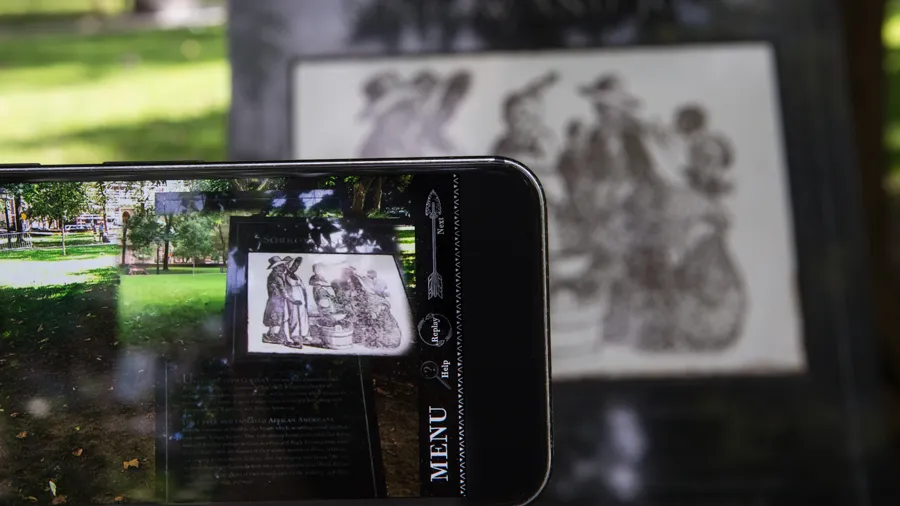Monument as “Viral Event”: An Interview with Marisa Williamson

Multi-media performance and installation artist Marisa Williamson is rethinking monuments, as part of our ongoing Monument Lab. Currently a visiting lecturer at Rutgers University’s Mason Gross School of the Arts, Williamson spent the last several months researching, designing, and creating Sweet Chariot: The Long Journey to Freedom through Time. This free app (available for Android and iOS phones) takes the user on an interactive journey through Philadelphia’s hidden history, illuminating stories of the African American struggle for freedom from Washington Square to Weccacoe Park in South Philadelphia.
Have you ever made an app as part of an art project before? Can you talk a little bit about the decision to enact your Monument Lab project using an app as the vehicle?
I had never made an app. Apps are almost everywhere now—very meme-like. The word “memes” was coined by Richard Dawkins to describe the gene-like quality of easily shared images. The viralness of apps made me think an app could be a good vehicle for a monument. It could pass images and words on to others—an invitation to be a part of a family. I wanted the monument to be a viral event—a portal to the past hovering right between Facebook and Twitter.
You’ve done a lot of work around Sally Hemings in other projects. What was it like to explore another character/persona/historical person?
I had been making work about and embodying Sally Hemings, Thomas Jefferson’s enslaved mistress. She was trapped in a world where her body was not her own. The work she performed as a slave was that of a housekeeper, bearer of children, substitute for a wife, silent witness to and victim of the enduring violence of slavery in America’s most revered home. She was unpaid and devalued for her sex work, her housework, the work she did to survive in a racist, sexist, colonial world.
Sweet Chariot is a break from that project. I was feeling exhausted by the performance of such a complicated persona. Through Sweet Chariot, I have been able to tell other stories. To bring the stories of African Americans in colonial Philadelphia to life allows me to add voices to the chorus that Hemings is a part of. Black lives are varied. The voices of black Americans are dynamic. By bringing a few of them together, I felt the demands for justice and songs of freedom resonated all the more powerfully and clearly.

The main icon for the app reminds me of Kara Walker’s silhouette work. Can you talk a little bit about the influences behind this project, artistic or otherwise?
That series of images was taken around the time of a performance I did at Invisible-Exports in NY titled After Kara Walker / Before Clifford Owens. I had dressed and made myself up to look like one of Kara Walker’s silhouettes. I mimed charades with an audience of forty people in the small gallery. My performance was followed by a performance by Clifford Owens. Both his and Kara’s works have had an influence on the form and quality of my work.
What’s your favorite monument?
I’ve sought and found peace at the William Penn statue, Toleration, located on a rocky elevation in Wissahickon Park near where I grew up. In lower Manhattan, blocks from the African Burial Ground National Monument (a favorite), the 9/11 Memorial fountains are an effective visual metaphor for the deep wound that we’re incapable of healing, the perpetual cascade of violence we’re trapped in, and the dark void left when our monuments to capitalism are destroyed. It’s heartbreaking.
Is the app the monument, or is the journey the monument?
The journey. The app is your ticket.
Lead Monument Lab partners include the City of Philadelphia; Philadelphia Parks & Recreation; Office of Arts, Culture, and the Creative Economy; Historic Philadelphia; Independence National Historic Park; Penn Institute for Urban Research; Pennsylvania Academy of the Fine Arts; Price Lab for Digital Humanities; and the University of Pennsylvania.
Major support for Monument Lab projects staged in Philadelphia’s five squares has been provided by The Pew Center for Arts & Heritage.
An expanded artist roster and projects at five neighborhood sites have been made possible by a significant grant from the William Penn Foundation.
Lead corporate sponsor is Bank of America.
Additional support has been provided by Susanna Lachs & Dean Adler, William & Debbie Becker, CLAWS Foundation, Comcast NBCUniversal, Davis Charitable Foundation, Hummingbird Foundation, J2 Design, National Endowment for the Arts, Nick & Dee Adams Charitable Fund, Parkway Corporation, PECO, Relief Communications LLC, Sonesta Philadelphia Rittenhouse Square, Stacey Spector & Ira Brind, Tiffany Tavarez, Tuttleman Family Foundation, Joe & Renee Zuritsky, and 432 Kickstarter backers. Support for Monument Lab‘s final publication provided by the Elizabeth Firestone Graham Foundation.
Media partner: WHYY